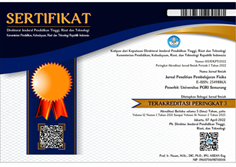Predicting Waste Production Trends in Palu City Using Linear Regression Analysis
DOI:
https://doi.org/10.26877/asset.v6i3.523Keywords:
Linear Regression, Linear Regression Analysis, Waste Volume Prediction, Mean Absolute Error (MSE), Mean Absolute Percentage Error (MAPE)Abstract
The aim of this research is to obtain predicted results for the volume of waste in Palu City. In Helping the Environmental Agency One of the complex aspects of the waste problem in Palu City is the lack of waste facilities, there is no basic reference for predicting the movement of waste carried out by the Environmental Agency. If this is left unchecked then the waste in Palu City will never be completely resolved. The algorithm chosen is a linear regression algorithm which can help make good predictions, one of which can create waste volume traffic which is useful for knowing the rise and fall of waste volume in each area. in Palu City, so it is a concern. For the community, it is important to protect the environment from waste. Therefore, the Linear Regression Method is used to predict the value of the dependent variable if the independent variable has a value that is known to describe the level of waste pollution. Waste production in the Palu City area to provide information to the Palu City Environmental Service regarding waste production which continues to increase every year. Trash Trends that occur in Palu City using the previous dataset, based on Trend results showing the accumulated volume of waste in Palu City. The highest waste volume occurred in 2017 to 2021, around 350,000 (kg/person/month), the lowest volume occurred in 2021, around 200,000 (kg/person/month). shows that the analysis carried out is as good as possible. The system creation process begins with creating a flowchart, collecting waste volume data, determining an algorithm that can manage waste data, and determining an algorithm that can predict data that shows trends.
References
. G., RH Laluma, and A. Prasetya, "Prediction of Waste Management Volume and Rates in Bandung City Using the Linear Regression Method," Techno-Socio Ekon. , vol. 15, no. 1, p. 49, 2022, doi: 10.32897/techno.2022.15.1.1195.
A. Mathematics, "Prediction of Talangagung Landfill Waste Volume Using a Dynamic Systems Approach," pp. 1–23, 2016.
I. Irwan, FN Ichsan, N. Gistituati, and S. Marsidin, "Education Policy Analysis Regarding Learning Implementation During the Covid 19 Emergency Period," J. Manaj. Educator. , vol. 9, no. 2, pp. 89–95, 2021, doi: 10.33751/jmp.v9i2.4238.
A. Hidayat, MT Ziyad, and C. Juliane, "Predicting Waste Volume in West Java Using the Linear Regression Method," vol. 10, no. 1, 2023.
JA Uswary, HR Ngemba, S. Hendra, and A. Kasim, "Wina Sentosa Bottled Water Distribution System Using Web-Based Distribution Requirement Planning and Trend Moment Algorithms," no. March 2023, pp. 1–9.
EE Nugraheni, "Prediction of Capacity of Cipeucang Final Disposal Site (TPA) South Tangerang City in 2031," UIN Syarif Hidayatullah , p. 156, 2017.
M. Audina, "Prediction and Analysis of Final Waste Disposal Sites (Tpa) in Padang City," J. Buana , vol. 2, no. 2, p. 423, 2018, doi: 10.24036/student.v2i2.93.
I. Djakaria, S. Guritno, and SH Kartiko, "Visualization of Iris Data Using Principal Component Analysis and Kernel Principal Component Analysis Visualization of Iris Data Using Principal Component Analysis and Kernel Principal Component Analysis," J. ILMU BASIC , vol. 11(1), no. 1, pp. 31–38, 2010.
MAH Putra, M. Mutiani, J. Jumriani, and MRN Handy, "The Development of a Waste Bank as a Form of Community Participation in Waste Management," Kalimantan Soc. Stud. J. , vol. 2, no. 1, p. 22, 2020, doi: 10.20527/kss.v2i1.2460.
S. Kosasi, S. Pontianak, J. Merdeka, N. 372 Pontianak, and K. Barat, "Application of the Backpropagation Neural Network Method to Predict School Exam Scores," J. Teknol. , vol. 7, no. 1, pp. 20–28, 2014, [Online]. Available: https://journal.akprind.ac.id/index.php/jurtek/article/view/1012
SS Mukrimaa et al. ," J. Researcher. Educator. School Teacher. Basics , vol. 6, no. August, p. 128, 2016.
AA Hardy, AA Rohmawati, and SS Prasetyowati, "Prediction of Bandung City Traffic Classification Using Machine Learning and Spatial Analysis," J. Media Inform. Budidharma , vol. 6, no. 4, p. 1861, 2022, doi: 10.30865/mib.v6i4.4538.
NR Feta and AR Ginanjar, "Comparison of the Kernel Function of Support Vector Machine Methods for Classification Modeling Against Comparison of the Kernel Function of Support Vector Machine Method for Modeling Classification of Soybean Plat Disease," J. Ilm. Computer Science, Science and Technology. Apply. , vol. 1, no. 1, pp. 33–39, 2019.
NS Fauziah and RD Dana, "Implementation of the Naive Bayes Algorithm in Classifying the Welfare Status of the Gunungsari Village Community," Blend Sains J. Tek. , vol. 1, no. 4, pp. 295–305, 2023, doi: 10.56211/blendsains.v1i4.234.
SHS Herho, "Data Visualization Tutorial Using Seaborn," Itb , pp. 1–75, 2019.
M. Daenie and H. Rizqi, "Implementation of Waste Management Policy in the City of Semarang," Public Serv. Gov. J. , vol. 2, no. 01, p. 96, 2021, doi: 10.56444/psgj.v2i01.1969.
GN Ayuni and D. Fitrianah, "Application of the Linear Regression method to predict property sales at PT XYZ," J. Telemat. , vol. 14, no. 2, pp. 79–86, 2019, [Online]. Available: https://journal.ithb.ac.id/telematics/article/view/321
Normah, B. Rifai, S. Vambudi, and R. Maulana, "Vtuber Development Sentiment Analysis Using the SMOTE-Based Support Vector Machine Method," J. Tek. Comput. AMIK BSI , vol. 8, no. 2, pp. 174–180, 2022, doi: 10.31294/jtk.v4i2.
WAL Sinaga, S. Sumarno, and IP Sari, "The Application of Multiple Linear Regression Method for Population Estimation of Mount Malela District," JOMLAI J. Mach. Learn. Artif. Intel. , vol. 1, no. 1, pp. 55–64, 2022, doi: 10.55123/jomlai.v1i1.143.
Yuli Mardi, "Data Mining: Classification Using the C4 Algorithm. 5 Data mining is part of the Knowledge Discovery in Database (KDD) process stage. Edik Informatics Journal," J. Edik Inform. , vol. 2, no. 2, pp. 213–219, 2019.











